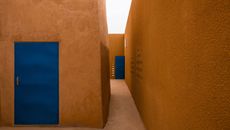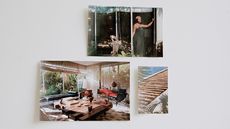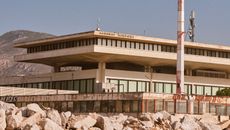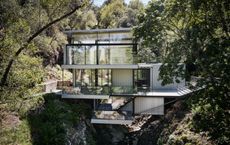Atelier Inhyah on sustainable ecosystems, craft, and a local approach
Atelier Inhyah from Ivory Coast is part of our series of profiles of architects, spatial designers and builders shaping West Africa's architectural future
- (opens in new tab)
- (opens in new tab)
- (opens in new tab)
- Sign up to our newsletter Newsletter
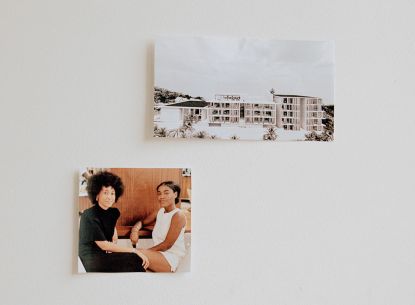
Atelier Inhyah is a story of two friends, Assarah Adoum from Tchad and Tara-Aude Koffi from Ivory Coast. They graduated from the École Spéciale d’Architecture de Paris in 2019, and went on to work for French and Ivorian firms. But soon, they both felt the need to create a practice relevant to their cultural backgrounds, and so they decided to start their own firm in 2020: ‘We are inspired by where we are from, while being relevant to our time.’

West African studios: Atelier Inhyah
Abiding by their ethos, they chose to settle in Abidjan: ‘a sub-Saharan hub for architecture despite having had its share of issues to address,’ as Koffi describes it. Aside from more traditional residential and commercial projects, Inhyah is interested in creating a sustainable ecosystem that would benefit local craftspeople. ‘We created a line of home accessories and furniture for that reason,’ Koffi explains. Being a fairly young practice, Inhyah aims to harness the capital’s growing sensibility to architectural innovation, by directing it towards a contemporary architecture that is inherently African: ‘We want people to understand that contemporary architecture answers to its time, yes, but also to its place.’

Inhyah’s latest project is a series of eco-lodges for a private client. ‘It shows what we are really about – we aim to have an architecture suitable to the cultural context and climate,’ says Koffi. To achieve this goal, the studio is putting emphasis on local know-how and materials. The duo are constantly learning, improving and developing their interest in education surrounding architecture in Africa. Indeed they have observed that architecture in Africa often leans toward occidental designs – something that in their view hinders creativity. They seek to challenge this by exploring elements of vernacular architecture – ranging from the Nubian vault to the thermal principle of earth architecture. ‘Once we draw from our know-how, our own architectural history, there is an abundance of ingenuity and resourcefulness that appears,’ Koffi insists. They want to encourage a specific education that fosters an understanding of local materials and techniques, which are currently fading away amid an imported ‘modern’ Ivorian landscape.

More unique to Abidjan, the dangers of hiring non-qualified practitioners results in disorganised and unsafe structures that do not respect planning regulations. Koffi says, ‘it is becoming urgent to deconstruct the perceived inaccessibility of the architect, and raise awareness regarding the need to hire an architect.’ At the same time, the difficulties Koffi and Adoun have come across on and off the field highlighted the blatant underrepresentation of women in the profession. ‘We have to work twice as hard as women,’ Koffi explains. For all those reasons, education is a medium through which they want to reach similar young African practices and foster a discussion around urbanism on the continent.
Inhyah’s next step is to grow and learn, to see how it can better impact that very complex African architectural landscape. ‘We hope to be the new generation of architects that challenges and tackle all the issues talked about.’ Koffi and Adoun’s clearest aspiration is to develop a sustainable city as a way to materialise the endless ways traditional African architecture can be reinvented.

West African studios: the series
From Senegal to Nigeria, and from Niger to the Ivory Coast, West Africa is vast and brimming with potential. A powerful mix of peoples and cultures, and in some nations, exponential demographic and economic growth, makes this part of the world a locus of change. The result? A dynamic new generation of studios that operate in the architecture realm and push the boundaries of their field to a promising future. Architects, spatial designers and builders converge here to create a unique, rich melting pot of fresh thinking and innovation that will no doubt reshape the way we think about architecture globally.
Atelier Inhyah (opens in new tab)
A version of this story appears in January 2023 Wallpaper*, The Future Issue, available now in print, on the Wallpaper* app on Apple iOS, and to subscribers of Apple News +. Subscribe to Wallpaper* today (opens in new tab)
-
 Men’s engagement rings for modern grooms
Men’s engagement rings for modern groomsMen’s engagement rings, whether classic or colourful, make for sentimental tokens
By Hannah Silver • Published
-
 Longchamp unites with D’heygere on a playful collection made to ‘transform the everyday’
Longchamp unites with D’heygere on a playful collection made to ‘transform the everyday’Inspired by Longchamp’s foldaway ‘Le Pliage’ bag, this collaboration with Paris-based jewellery and accessories designer Stéphanie D’heygere sees pieces that ‘transform and adapt’ to their wearer
By Jack Moss • Published
-
 Last chance to see: Marc Newson’s all-blue designs in Athens
Last chance to see: Marc Newson’s all-blue designs in AthensGagosian gallery Athens presents new blue furniture and objects by Marc Newson
By Rosa Bertoli • Published
-
 Niger’s Atelier Masōmī designs to ‘elevate, dignify and provide a better quality of life’
Niger’s Atelier Masōmī designs to ‘elevate, dignify and provide a better quality of life’Atelier Masōmī from Niger is part of our series of profiles of architects, spatial designers and builders shaping West Africa's architectural future
By Ellie Stathaki • Published
-
 Jeannette Studio brings poetry to architecture
Jeannette Studio brings poetry to architectureJeannette Studio from Ivory Coast is part of our series of profiles of architects, spatial designers and builders shaping West Africa's architectural future
By Aude Tollo • Published
-
 Athens in 2023: architecture and creativity are on the up
Athens in 2023: architecture and creativity are on the upAthens is enjoying its very own metamorphosis with a plethora of recently restored buildings, large-scale projects and fresh new openings
By Ellie Stathaki • Published
-
 The Fendi factory in Tuscany disappears into the landscape
The Fendi factory in Tuscany disappears into the landscapeThe new Fendi Factory in Italy, set in the rolling hills of Tuscany, is the brainchild of Milan architecture studio Piuarch and the luxury brand
By Ellie Stathaki • Published
-
 Senegal’s Mamy Tall on city planning, bioclimatic construction and heritage
Senegal’s Mamy Tall on city planning, bioclimatic construction and heritageMamy Tall from Senegal is part of our series of profiles of architects, spatial designers and builders shaping West Africa's architectural future
By Ellie Stathaki • Published
-
 Park House is a minimalist, art-filled family home in Melbourne
Park House is a minimalist, art-filled family home in MelbournePark House by Mim Design and Pleysier Perkins is an art-filled family home in Melbourne including a bold, concrete extension
By Nick Compton • Published
-
 Year in review: top 10 houses of 2022, selected by Wallpaper* architecture editor Ellie Stathaki
Year in review: top 10 houses of 2022, selected by Wallpaper* architecture editor Ellie StathakiWallpaper’s Ellie Stathaki reveals her top 10 houses of 2022 – from modernist reinventions to urban extensions and idyllic retreats
By Ellie Stathaki • Published
-
 This bijou Sonoma County house is in sync with the landscape
This bijou Sonoma County house is in sync with the landscapeAn open and contextual Sonoma County house, Leit House is designed by San Francisco’s Schwartz and Architecture
By Ellie Stathaki • Published



